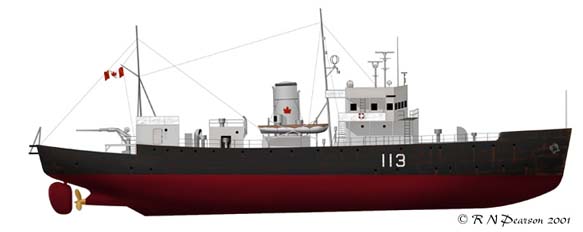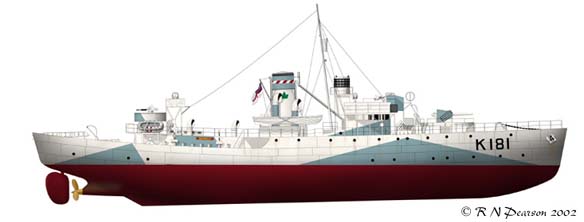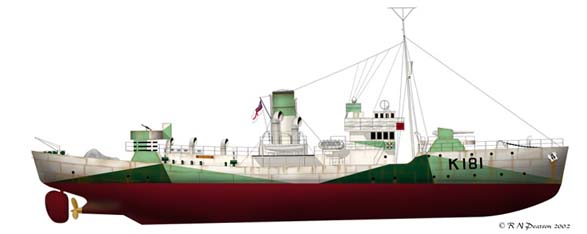HMCS Sackville: The Last Flower: 1941-2000
Out of 269 Flower Class Corvettes built in Britain and Canada between 1940 and 1945 only one survives today – HMCS Sackville – and her survival is more the result of good fortune, rather than good planning.
Built by the Saint John Dry Dock and Shipbuilding Co. Ltd of Saint John NB, HMCS Sackville was launched on 15 May 1941, and commissioned into the RCN on 30 December 1941. . .. at the time of her commissioning Sackville had spent 19 months and three days from the time she was ordered - twice as long as average for a Flower. In fact, only HMS Balsam took longer to build (19 months and 12 days).
Her first commanding officer, Lt W.R. Kirkland, RCNR joined on 2 January 1942. By March 1942 Sackville was still not ready for action and Kirkland was discharged as 'Unsuitable'. At the same time her crew was scattered amongst other ships of the fleet. In their place the already trained crew of HMCS Baddeck (Lt Alan Easton, RCNR) was transferred to Sackville. Finally, on 15 May 1942, Sackville left Halifax to join the war.
Escort Group C-3
Assigned to the Mid-Ocean Escort Force (MOEF). Sackville joined the veteran destroyers Saguenay and Skeena in Escort Group C-3 along with other newcomers Galt and Wetaskiwin. These three corvettes were replacements for the previous C-3 corvettes which were now undergoing refit en masse.
While escorting convoy ON 115 during early August 1942, Sackville was involved in attacking three different U-boats within the space of 12 hours, damaging U-43 and U-552.
Sackville's appearance in Summer 1942 is as above. At this time she is basically as built with a few additions. She sports the highly ineffective Canadian designed Sw1C radar at the masthead. While a great technical achievment, it proved impractical in actual usage. It was to be at least another year before Canadian escorts saw the much more effective Britsh type 271 radar installed. The colours are interesting in that the WA Blue has been replaced by ' deck green'. I am unsure whether MS2 is meant by this, so I have chosen to use a medium green colour. Shortly after this she added the C-3 Barber Pole band to the funnel. This gave rise to their being known as the "Barber Pole Group". However when the corvettes of C-3 went in for refit in May 1943, EG C-5 stole the band for themselves. So beware the trap of assigning ships wearing the band to C-3 without being sure of the dates.
Refit
Sackville arrived in LIverpool, Nova Scotia on 13 January 1943 to begin 20 weeks of refitting. The main thrust of the work entailed rebuilding all her mnachinery, and there were few external changes. She emerged from this refit with her minesweeping gear removed and the bridge wings extended to accomodate 20mm Oerlikons. During this time, LT Easton was transferred to take command of the new Frigate, HMCS Matane and in his place Lt. H A Rankin RCNVR assumed command on 10 April 1943.
Sackville joined EG C-1 under the British Frigate Itchen and the Canadian destroyer St. Croix - although groups were nominally of one nation, designated by its letter A= American, B= British, C= Canadian, they were usually composed of whatever ships were available. In fact most American groups were made up of Canadian ships!!!
The loss of St Croix, Polyanthus and Itchen
In July 1943, a new group was formed - EG9 - from the ships of C-1 along with two from C-2. This was a special unit designated to hunt submarines rather then be tied to a specific convoy. While covering two convoys (ONS 18 escorted by B-3 and ON 202 escorted by C-2) EG9 was ordered to combine forces with the other two groups to protect the convoys from the gathering U-boats.
On the afternoon of 20 September 1943 HMCS St Croix was sunk by U-305, however there was no ship immediately available to rescue the survivors, so over 100 men spent the night in open boats until they could be picked up in the morning. Eventually HMS Polyanthus was detailed to screen the rescue of St Croix's surviviors, but she was not heard from, so Itchen went off looking for her – Polyanthus had beensunk by U-952 with one survivor being picked up by Itchen. The next day Itchen picked up 70 of St Croix's men .. but the worst was still to come. ..
On the 22 September, Itchen gained a radar contact. Itchen and the corvette Morden opened fire and moments later the U-boat fired two torpedoes at the ships .. one exploded in Morden's wake, however the other exploded directly below Itchen and she disappeared in a massive explosion.
One man from St Croix and two from Itchen were rescued. This was all that was left of three ship's companies.
EG9 was disbanded with Sackville and Morden going to EG C-2
Escort Group C.2 and Modernization
Sackville spent the autumn of 1943 with EG C-2 escorting convoys between Britain and Canada. By December she was starting to experience more and more frequent engine problems and she was once again due for refit and modernization. However the RCN had no intention of modernizing the remaing short focsle corvettes. they had enough of the newer long focsle corvettes and frigates coming into service that the older corvettes were just going to have routine maintenance done to them. Eventually, in the interest of crew morale, it was decided to upgrade the older corvettes as well, and consequently Sackville went to Galveston Texas for her long awaited modernization. Arriving there on 28 February 1944, she had her focsle extended; a new open bridge fitted; hedgehog added; the mast was moved to a position abaft the bridge; the two 16' dinghys were replaced with a single 27' whaler; new electronics were fitted and numerous other details attended to.
Sackville returned to Halifax on 15 May 1944. On the 17th Lt Rankin left the ship and Lt A R HIcks arrived to take command. She then went to Bermuda to work up following the refit and was finally ready for the war again on 29 June when she sailed with C-2 as escort for HX297. At the conclusion of this trip she was in Londonderry for a routine boiler cleaning which in the end was to prove her salvation.
The cleaning revealed a flaw in her boilers - one was leaking. After repairs it again failed and an inspection showed that faulty construction was at fault .. Sackville's war was now over. If her boiler had failed earlier in the war it would have been repaired as escorts were badlt neeeded. Now, however, they were a dime a dozen and one 'damaged' escort wasn't going to alter the balance, and she may have been scrapped then and there. However There was one saving grace, Sackville had just been thoroughly modernized, therefore she was assigned to the officer training establishment HMCS King's to serve as training ship on 29 August 1944.
Postwar
One month later it was decided to convert Sackville to become a Loop Layer for the ring of detection cables around ports. Her damaged boiler was removed, its location provided an excellent storage well for the cables. Originally there were few external changes .. gone was the 4" gun and in its place were a pair of cranes. She served in this role until March 1946 at which time she entered the reserve fleet.
The Korean War saw Sackville ready to provide her unique skills if needed, but she wasn't needed. However in 1953 it was decided to convert her once again - this time to a research vessel. She emerged from this refit looking much the same as before, but with no armament [eventually I plan to show her in this guise - RNP]. The only difference really being the black hull with 532 on its side (by the late 1950s this was changed to 113). In 1964 a laboratory was added tje the aft superstructure. She kept this same basic appearance until her next major change in1968 when she had a new fully enclosed bridge.

Sackville is seen as she appeared circa 1982, prior to her conversion
back to her 1944 guise. Of interest is the new bridge and laboratory aft.
By the 1970s interest was beginning to arise in preserving a Flower Class corvette for future generations. Towards this end various groups in Canada began to search for a suitable subject to purchase for such a role. The eventually settled upon the former HMCS Louisburg II which had beens old to the Dominican Republic following WWII. However she was damaged beyond repair in Hurricane David in 1979. . this left one Flower* HMCS Sackville.
Negotiations then began to save Sackville, especially as it was learned that she was being slated for retirement soon. Her final operational cruise was in July 1982, and she was paid off in December 1982, with final details of her transfer to the Canadian Naval Corvette Trust taking place on 28 October 1983.
The original idea was to convert her back to her 1942 appearance, however in the end it was deemed cheaper to backdate her to her 1944 appearance, and this is how she looks today.

Although supposed to depict Sackville in 1944, the current appearance
isn't completely accurate. By 1944 the funnel bands were gone. There is
also some minor differences to the camouflage pattern. But by-and-by,
she does look good. To see some current photos of her, go to the
LINKS page and follow the Sackville links.
SOURCES
-
HMCS Sackville 1941-1985: Milner, Marc
-
Corvettes of the RCN 1939-45: Macpherson, Ken & Milner, Marc
-
HMS Bryony - Tribute to a Flower: Horabin, Ron
* Actually there was at least one other Flower still in existance - the former HMS Bryony was in Norwegian service as a weathership until 1980.
